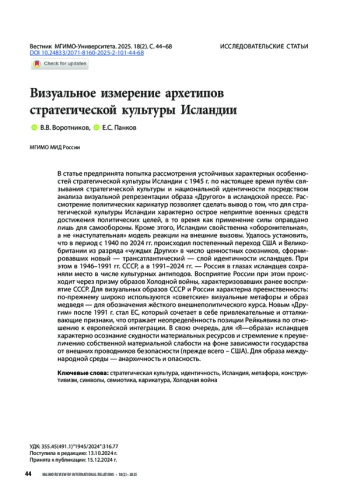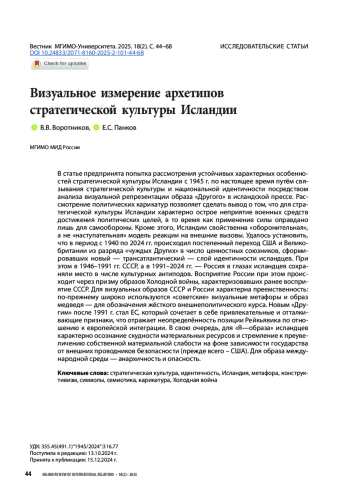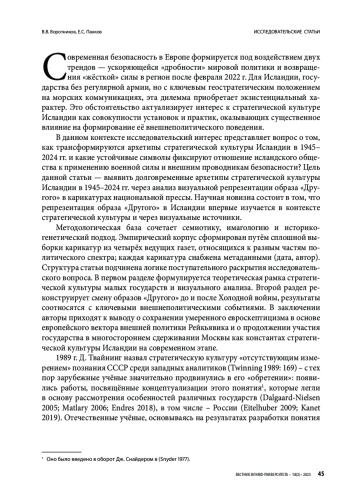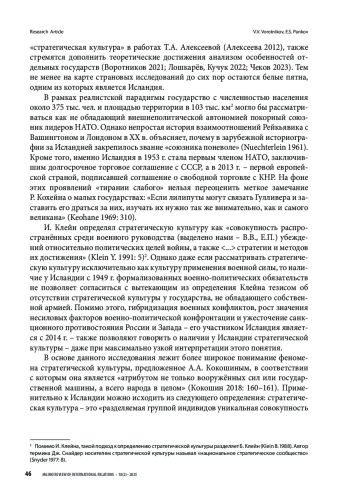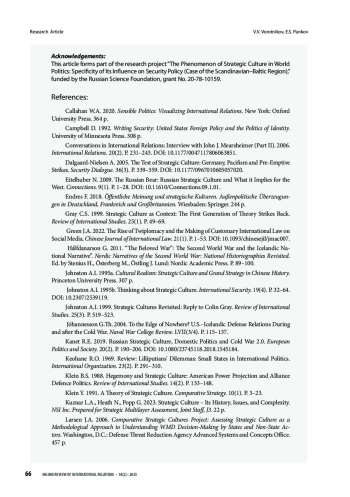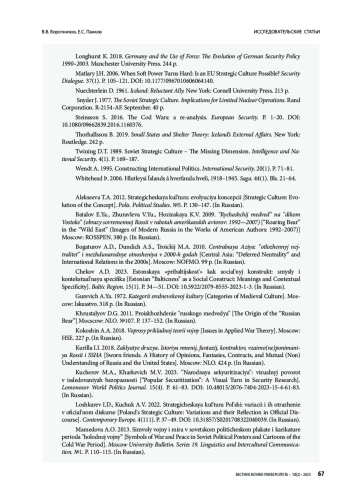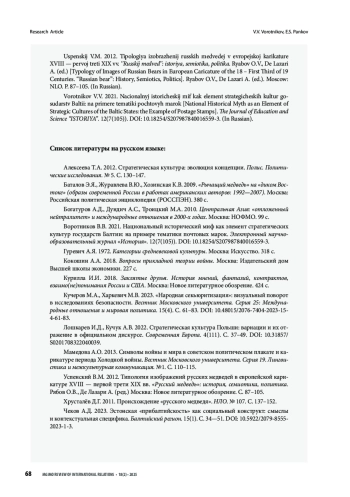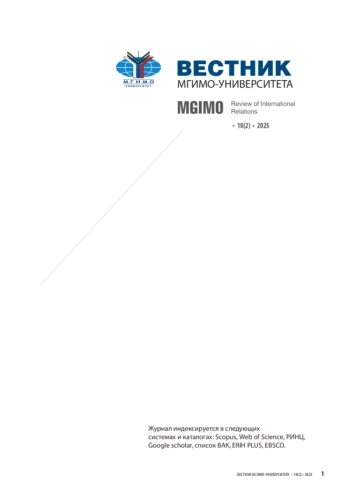1. Callahan W.A. 2020. Sensible Politics: Visualizing International Relations. New York: Oxford University Press. 364 p.
2. Campbell D. 1992. Writing Security: United States Foreign Policy and the Politics of Identity. University of Minnesota Press. 308 p.
3. Conversations in International Relations: Interview with John J. Mearsheimer (Part II). 2006. International Relations. 20(2). P. 231-243. https://doi.org/10.1177/0047117806063851.
4. Dalgaard-Nielsen A. 2005. The Test of Strategic Culture: Germany, Pacifism and Pre-Emptive Strikes. Security Dialogue. 36(3). P. 339-359. https://doi.org/10.1177/0967010605057020.
5. Eitelhuber N. 2009. The Russian Bear: Russian Strategic Culture and What it Implies for the West. Connections. 9(1). P. 1-28. https://doi.org/10.11610/Connections.09.1.01.
6. Endres F. 2018. Öffentliche Meinung und strategische Kulturen. Außenpolitische Überzeugungen in Deutschland, Frankreich und Großbritannien. Wiesbaden: Springer. 244 p.
7. Gray C.S. 1999. Strategic Culture as Context: The First Generation of Theory Strikes Back. Review of International Studies. 25(1). P. 49-69.
8. Green J.A. 2022. The Rise of Twiplomacy and the Making of Customary International Law on Social Media. Chinese Journal of International Law. 21(1). Р. 1-53. https://doi.org/10.1093/chinesejil/jmac007.
9. Hálfdanarson G. 2011. “The Beloved War”: The Second World War and the Icelandic National Narrative”. Nordic Narratives of the Second World War: National Historiographies Revisited. Ed. by Stenius H., Österberg M., Östling J. Lund: Nordic Academic Press. P.89-100.
10. Johnston A.I. 1995a. Cultural Realism: Strategic Culture and Grand Strategy in Chinese History. Princeton University Press. 307 p.
11. Johnston A.I. 1995b. Thinking about Strategic Culture. International Security. 19(4). P. 32-64. https://doi.org/10.2307/2539119.
12. Johnston A.I. 1999. Strategic Cultures Revisited: Reply to Colin Gray. Review of International Studies. 25(3). P. 519-523.
13. Jóhannesson G.Th. 2004. To the Edge of Nowhere? U.S.-Icelandic Defense Relations During and after the Cold War. Naval War College Review. LVII(3/4). Р. 115-137.
14. Kanet R.E. 2019. Russian Strategic Culture, Domestic Politics and Cold War 2.0. European Politics and Society. 20(2). P. 190-206. https://doi.org/10.1080/23745118.2018.1545184.
15. Keohane R.O. 1969. Review: Lilliputians’ Dilemmas: Small States in International Politics. International Organization. 23(2). P. 291-310.
16. Klein B.S. 1988. Hegemony and Strategic Culture: American Power Projection and Alliance Defence Politics. Review of International Studies. 14(2). P. 133-148.
17. Klein Y. 1991. A Theory of Strategic Culture. Comparative Strategy. 10(1). P. 3-23.
18. Kuznar L.A., Heath N., Popp G. 2023. Strategic Culture - Its History, Issues, and Complexity. NSI Inc. Prepared for Strategic Multilayer Assessment, Joint Staff, J3. 22 p.
19. Larsen J.A. 2006. Comparative Strategic Cultures Project: Assessing Strategic Culture as a Methodological Approach to Understanding WMD Decision-Making by States and Non-State Actors. Washington, D.C.: Defense Threat Reduction Agency Advanced Systems and Concepts Office. 457 p.
20. Longhurst K. 2018. Germany and the Use of Force: The Evolution of German Security Policy 1990-2003. Manchester University Press. 244 p.
21. Matlary J.H. 2006. When Soft Power Turns Hard: Is an EU Strategic Culture Possible? Security Dialogue. 37(1). P. 105-121. https://doi.org/10.1177/0967010606064140.
22. Nuechterlein D. 1961. Iceland: Reluctant Ally. New York: Cornell University Press. 213 p.
23. Snyder J. 1977. The Soviet Strategic Culture. Implications for Limited Nuclear Operations. Rand Corporation. R-2154-AF. September. 40 p.
24. Steinsson S. 2016. The Cod Wars: a re-analysis. European Security. P. 1-20. https://doi.org/10.1080/096 62839.2016.1160376.
25. Thorhallsson B. 2019. Small States and Shelter Theory: Iceland’s External Affairs. New York: Routledge. 242 p.
26. Twining D.T. 1989. Soviet Strategic Culture - The Missing Dimension. Intelligence and National Security. 4(1). Р. 169-187.
27. Wendt A. 1995. Constructing International Politics. International Security. 20(1). P. 71-81.
28. Whitehead Þ. 2006. Hlutleysi Íslands á hverfanda hveli, 1918-1945. Saga. 44(1). Bls. 21-64.
29. Алексеева Т.А. 2012. Стратегическая культура: эволюция концепции. Полис. Политические исследования. № 5. С. 130-147.
30. Баталов Э.Я., Журавлева В.Ю., Хозинская К.В. 2009. «Рычащий медведь» на «диком Востоке» (образы современной России в работах американских авторов: 1992-2007). Москва: Российская политическая энциклопедия (РОССПЭН). 380 c.
31. Богатуров А.Д., Дундич А.С., Троицкий М.А. 2010. Центральная Азия: «отложенный нейтралитет» и международные отношения в 2000-х годах. Москва: НОФМО. c. 99
32. Воротников В.В. 2021. Национальный исторический миф как элемент стратегических культур государств Балтии: на примере тематики почтовых марок. Электронный научнообразовательный журнал «История». 12(7(105)). https://doi.org/10.18254/S207987840016559-3.
33. Гуревич А.Я. 1972. Категории средневековой культуры. Москва: Искусство. 318 c.
34. Кокошин А.А. 2018. Вопросы прикладной теории войны. Москва: Издательский дом Высшей школы экономики. 227 c.
35. Курилла И.И. 2018. Заклятые друзья. История мнений, фантазий, контрактов, взаимо(не)понимания России и США. Москва: Новое литературное обозрение. 424 c.
36. Кучеров М.А., Харкевич М.В. 2023. «Народная секьюритизация»: визуальный поворот в исследованиях безопасности. Вестник Московского университета. Серия 25: Международные отношения и мировая политика. 15(4). С. 61-83. https://doi.org/10.48015/2076-7404-2023-154-61-83.
37. Лошкарев И.Д., Кучук А.В. 2022. Стратегическая культура Польши: вариации и их отражение в официальном дискурсе. Современная Европа. 4(111). С. 37-49. https://doi.org/10.31857/ S0201708322040039.
38. Мамедова А.О. 2013. Символы войны и мира в советском политическом плакате и карикатуре периода «холодной войны». Вестник Московского университета. Серия 19. Лингвистика и межкультурная коммуникация. №1. С. 110-115.
39. Успенский В.М. 2012. Типология изображений русских медведей в европейской карикатуре XVIII - первой трети XIX вв. «Русский медведь»: история, семиотика, политика. Рябов О.В., Де Лазари А. (ред.) Москва: Новое литературное обозрение. C. 87-105.
40. Хрусталёв Д.Г. 2011. Происхождение «русского медведя». НЛО. № 107. С. 137-152.
41. Чеков А.Д. 2023. Эстонская «прибалтийскость» как социальный конструкт: смыслы и контекстуальная специфика. Балтийский регион. 15(1). С. 34-51. https://doi.org/10.5922/2079-85552023-1-3.
